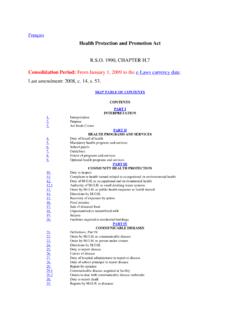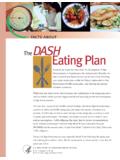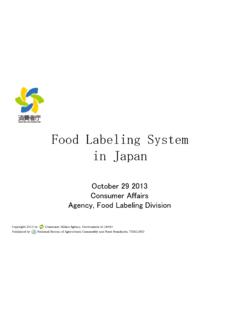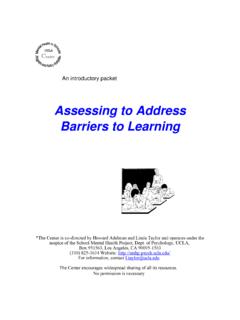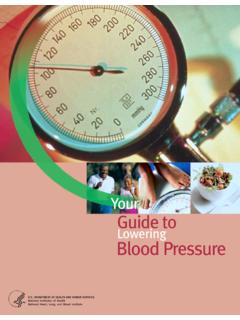Transcription of Canadian Food Labelling Requirements January 2018
1 Canadian Food Labelling Requirements January 2018 2 The Canadian Food Inspection Agency Food safety is the CFIA's top priority. Activity range: of facilities (federally-registered & NFR), undertaking preventive measures using a risk based approach food investigations and recalls related to fraudulent Labelling inspections for foreign pests and diseases of humane transportation of animals the import, export and domestic movement of horticulture, forestry and plant products. with exotic pest introductions and the control or eradication of quarantine pests. lab testing and environmental assessments of seeds, plants, feeds and fertilizers. CFIA s Legislative Authority for Food Food and Drugs Act (FDA) & Regulations (FDR) apply to all foods at all levels of trade, such as prepackaged foods, foods in non-retail containers, and some unpackaged foods Consumer Packaging and Labelling Act (CPLA) & Regulations (CPLR) apply to prepackaged foods sold directly to consumers at retail.
2 The FDA and CPLA prohibit the Labelling of foods in a manner that is false, misleading, deceptive or is likely to create an erroneous impression regarding its character, value, quantity, composition, merit or safety. Meat Inspection Act and Regulations (MIA & MIR) Fish Inspection Act and Regulations (FIA & FIR) Canada Agricultural Products Act (CAPA) (Dairy Products Regulations, Egg Regulations, Fresh Fruit and Vegetable Regulations, Honey Regulations, Organic Products Regulations, Maple Products Regulations , Processed Egg Regulations , Processed Products Regulations) 3 Coming in The new Safe Food for Canadians Act and Regulations consolidates the authorities of the: Fish Inspection Act Canada Agricultural Products Act Meat Inspection Act the food provisions of the Consumer Packaging and Labelling Act. 4 Proposed Safe Food for Canadians Regulations To come into force in 2018 Puts a greater emphasis on preventing food safety risks for all foods imported into Canada or sold across provinces.
3 The regulations would also apply to foods prepared for export. Would require food businesses to have preventive controls in place to identify and manage food safety risks before products are sold to consumers Consolidates 14 sets of existing regulations into one Link to SFCR on main CFIA site: 5 6 Imported & Manufactured Food Program (IMFP) The non-federally registered food sector incudes all food solely inspected under the FDA&R and not regulated by other federal trade and commerce acts. This represents ~70% of food sold in Canada, including a wide range of imported and domestic products, : Alcoholic beverages Fats, oils Bakery products Food additives Chocolate products Confectionary, snack foods Infant formula and foods The CFIA s Imported and Manufactured Food Program is responsible for enforcing legislation related to these foods *Soon, the manufacturing of many of these foods that leave the Province will be covered under the Safe Food For Canadians Regulations 7 Basic Labelling Requirements A great Labelling Reference for Industry is the On-line Labelling Tool (OLT), which you can access from the CFIA Website: or Directly: Foods Requiring a label Most prepackaged foods require a label [ , FDR; 10, CPLA].
4 Clerk served foods that are packaged upon request of a consumer are not regarded as "prepackaged and do not require a label . Clerk-served foods packaged by a clerk before the time of the sale are considered prepackaged products and are required to be fully labelled 8 Exemptions from Having a label One bite confections (sold individually) Fresh fruits or fresh vegetables packaged in a clear wrapper (can have price, bar or number codes, treatment) or confining band of less than width 9 10 Mandatory Labelling Requirements Bilingual Labelling Common Name Country of Origin Date Markings and Storage Instructions Identity and Principle Place of Business List of Ingredients and Allergens Net Quantity nutrition Labelling (including nutrition Facts Table (NFT)) -All mandatory label information must be clearly and prominently displayed and readily discernible to the purchaser or consumer under the customary conditions of purchase and use [ , FDR].
5 Bilingual Requirements All mandatory information must be shown on the label in both English and French, unless otherwise provided for in legislation [ , FDR]. Exemptions: - dealer name and address - shipping containers/non retail containers - common name of some alcoholic beverages - specialty foods - test market foods - local foods 11 12 Common Name Common name means [ , FDR]: Standardized name set out in the FDR or other regulations orange juice from concentrate, butter, chocolate, flour, bread, wine, olive oil, cherry pie filling etc. If the name is not prescribed, the name by which the food is commonly known, orange drink, candy bar, chocolate chip cookie, rice cracker, peanut butter, tapioca pudding etc. The common name must be shown on the principal display panel (PDP) [ , FDR; 12 CPLR] Prescribed Name of a Standardized Food, Example.: [S]. (Naming the fruit) Jam (a) shall be the product obtained by processing fruit, fruit pulp, or canned fruit, by boiling to a suitable consistency with water and a sweetening ingredient; (b) shall contain not less than (i) 45 per cent of the named fruit, and (ii) 66 per cent water soluble solids as estimated by the refractometer; (c) may contain (i) such amount of added pectin, pectinous preparation, or acid ingredient as reasonably compensates for any deficiency in the natural pectin content or acidity of the named fruit, (ii) a Class II preservative, (iii) a pH adjusting agent, and (iv) an antifoaming agent; and (d) shall not contain apple or rhubarb.
6 13 label Example: Wild Blueberry Cocktail Ingredients: Water, apple juice from concentrate, glucose fructose, citric acid, natural flavour, ascorbic acid Ingr dients: Eau, jus de pomme concentr , glucose-fructose, acide citrique, ar me natural, acide ascorbique. Food and Drug Reg s 14 15 Net Quantity The net quantity must be declared in metric units on the principal display panel of prepackaged foods for retail sale [12, CPLR; Weights and Measures Regulations] There are minimum type height Requirements for the numerals in the net quantity declaration, based on the area of the principal display surface. [14, CPLR] Declared by volume (liquids) or weight (solids) or sometimes by count (when established by trade practice) [CPLR 21 22] dinner rolls, gum 16 Dealer Name and Address The identity and principal place of business of the responsible party must be declared on the label [ , FDR; 10, CPLA; 31, CPLR], on any label panel except the bottom.
7 Exemption: fresh fruits & vegetables prepackaged on the retail premises, when visible & identifiable in the package - The principal place of business is the main location where actual company related enterprise occurs - Level of detail not prescribed, but should at least include city and province or Canada ( ABC Company, Toronto, Canada) Recommend address be complete enough for postal delivery! 17 Durable Life Date & Storage Instructions Best before date is required for products with a durable life of 90 days or less [ , FDR] FDR prescribes the format for declaring the best before date. If the year is required for clarity, it must be declared 1st followed by the month, then the day, Best before Best before/ Meilleur avant 12 JN 28 12 JN 28 Meilleur avant Best Before is based upon freshness, not safety, so it is not illegal to sell a product after that date.
8 Storage instructions are required if storage differs from normal room temperature , keep frozen , keep refrigerated List of Ingredients Requirement [ ] Prepackaged multi-ingredient foods must declare a list of ingredients and their components ( , FDR) unless an exemption applies (there are some!) (see slide in Additional content ) Location: any panel except the bottom. 18 19 List of Ingredients, Manner of Declaring All ingredients and their components must be declared in the ingredient list, in decreasing order by weight [ , FDR], unless an exemption applies exempts some ingredients from component declaration, butter, flour, flavourings, etc. Whereas some components must ALWAYS be declared, priority allergens, peanut oils, salt, glutamic acid and its salts, hydrolyzed plant protein, aspartame, potassium chloride etc.
9 Some ingredients may appear in any order at the end of the list of ingredients spices, seasonings & herbs (except salt), flavours, food additives, vitamins and minerals etc. Food Additives Any chemical substance added to food during preparation or storage and either becomes a part of the food or affects its characteristics for the purpose of achieving a technical effect anticaking agents, dough conditioners, colouring agents, preservatives, pH adjusting agents, etc. The 15 Lists of Permitted Food Additives are posted on Health Canada s website, allowed through Marketing Authorizations and incorporated by reference into the regulations. These lists are the official repository of substances permitted for use as food additives in or on foods marketed in Canada. 20 Food Allergen Definition 21 Any protein from any of the following foods or any modified protein, including any protein fraction ( hydrolyzed protein), that is derived from the following foods [ (1), FDR]: Almonds, Brazil nuts, cashews, hazelnuts, macadamia nuts, pecans, pine nuts, pistachios, walnuts Peanuts Sesame seeds Wheat or triticale Eggs Milk Soybeans Fish, crustaceans, shellfish Mustard seeds Gluten Definition Any gluten protein, modified protein or protein fractions from the grain of any of the following cereals or the grain of a hybridized strain created from at least one of the following cereals [ (1)]: Barley Oats Rye Triticale Wheat (all species, including kamut & spelt) 22 Sulphites Definition [ ] Sulphites means one or more of the food additives listed in column I of item 21 of the table to paragraph (3)(b), FDR.
10 Potassium bisulphite Potassium metabisulphite Sodium bisulphite Sodium dithionite Sodium metabisulphite Sodium sulphite Sulphur dioxide Sulphurous acid 23 24 24 Allergen Declaration - List of Ingredients How will this look on the label ? In parentheses immediately after the ingredient: Ingredients: flour (wheat), butter (milk), liquid albumin (egg), apricot jam with pectin, vegetable oil (soy), sugar, flavour, sulphites*. *New provision: sulphites may be shown at the end of the list of ingredients in any order. Added food allergen and gluten sources must be declared when present at any level, applicable to all ingredient generations. Bolding is not required, but not prohibited, by the new regulations, it is only done here to highlight the focus of the examples. 25 Allergen Declaration Contains Statement Food allergen & gluten sources and added sulphites can alternatively be declared.
